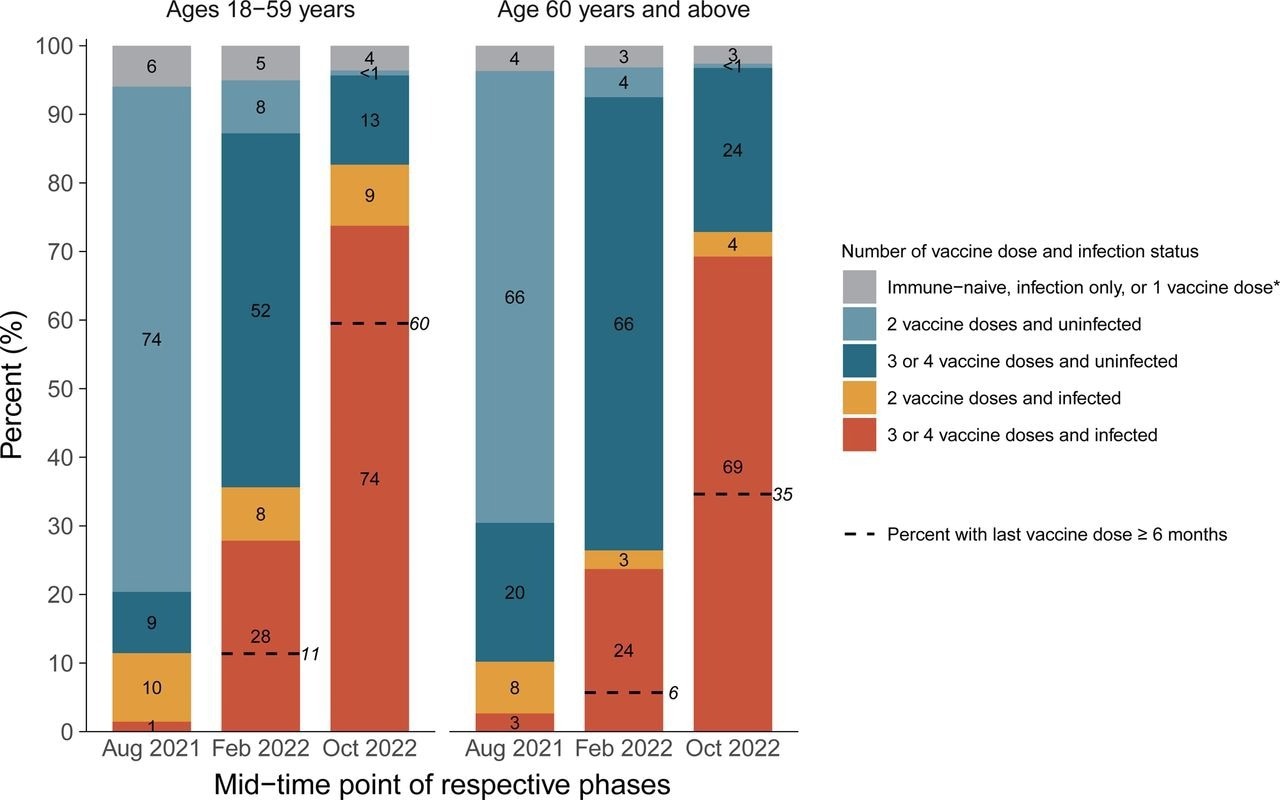In late 2021 and early 2022, the Omicron BA.1/1.1 variant of SARS-CoV-2 spread globally. During this period, hybrid immunity significantly reduced coronavirus disease 2019 (COVID-19) morbidity and mortality compared to previous years. Hybrid immunity offers partial protection against reinfection and a more robust defense against severe outcomes. However, most studies focus on hospitalized patients or those tested via polymerase chain reaction (PCR), not reflecting the general population. This gap hinders understanding the longevity and effectiveness of hybrid immunity.
Further research is needed to understand the long-term dynamics and effectiveness of hybrid immunity at a population level, especially considering varying infection and vaccination histories for transitioning from pandemic to endemic management of COVID-19.
About the study
The present study, conducted between May 2020 and December 2022, involved serial assessments of SARS-CoV-2 antibodies in a cohort of mostly vaccinated Canadian adults recruited from a national online polling platform. Participants reported their viral test–confirmed infections and sent self-collected dried blood spots to a central laboratory for analysis. The study focused on estimating the cumulative incidence of SARS-CoV-2 before and during the Omicron BA.1/1.1 and BA.2/5 waves, along with changes in antibody levels and age-specific immunity levels.
Highly sensitive and specific antibody assays were used to detect spike and nucleocapsid protein antigens, the latter being indicative of infection. The study evaluated the decay of spike protein antibodies post-vaccination and post-infection, noting that recent vaccination mitigated the decline in spike levels from older infections. The research team also correlated spike antibody and cellular responses in a convenience sample.
By the end of 2022, approximately 35% of adults over 60 had their last vaccine dose more than six months prior, and about 25% had not been infected. The cumulative incidence of infection rose significantly by December 2022, suggesting a role for hybrid immunity in reducing COVID-19 severity and mortality.
Study results
In the study, people who previously had SARS-CoV-2 infection showed more spike protein than those who did not, regardless of the number of vaccination doses received. This pattern was consistent among various demographics, including age groups, sex, and ethnicities. Particularly notable was finding out that adults who had received at least three shots from the vaccine and were sick more than half a year earlier had spike levels that went down quickly and kept going lower for nine months after getting vaccinated. On the other hand, adults who got sick in less than six months saw a slower decrease in spike amounts.

Cumulative incidence in each stratum of infection and vaccination in the pre-omicron wave, during the omicron BA.1/1.1 wave, and during the BA.2 and BA.5 waves by age group. *Including uninfected and infected cases. The first column in each age group represents the antibody and viral test positivity for the entire period prior to omicron, whereas the second column represents the values during the omicron BA.1/1.1 wave and the third during the BA.2/5 waves. By the last time period studied, the numbers of participants aged 15-59 who were N-positive, viral test–positive, and positive to both were 675 (41%), 37 (2%), and 699 (43%). The comparable numbers for participants aged 60 or more were 763 (44%), 35 (2%), and 500 (29%).
The research also showed that new vaccines helped stop the drop in spike levels from older sicknesses. In some people, the level of spike antibodies was linked to how their cells reacted. By the end of 2022, about 35% of adults over the age of 60 had their last vaccine dosage more than six months ago, and approximately 25% had not been infected.
The cumulative incidence of SARS-CoV-2 infection in the studied population increased dramatically from 13% before the emergence of the Omicron variant to 78% by December 2022, which equated to around 25 million infected adults. Despite this high incidence rate, the COVID-19 weekly death rate during the Omicron BA.2/5 waves was significantly lower than during the BA.1/1.1 wave, suggesting a protective effect of hybrid immunity.
Furthermore, the study found significant increases in infection rates among younger, i.e., 18-59 years, and older i.e., 60+ years adults, most of whom were vaccinated. By December 2022, the cumulative incidence rates in these age groups were approximately 86% and 75%, respectively. However, a significant proportion of older adults, who are most at risk of severe outcomes from COVID-19, either had not been vaccinated in over six months or remained uninfected.
Conclusions
The study highlights the protective nature of hybrid immunity against SARS-CoV-2 at a population level, with a focus on Canadian adults. By December 2022, nearly 80% of Canadian adults were infected, predominantly with Omicron variants, leading to significant morbidity and mortality but also contributing to hybrid immunity. Despite the high infection rate, death rates during Omicron BA.2 and BA.5 were significantly lower than during BA.1/1.1, suggesting hybrid immunity's role in reducing severe disease. Hospitalizations have decreased since summer 2022, especially in intensive care units. The study also found that recent vaccination helped maintain spike protein levels, indicating its importance in sustaining immunity. This research underscores the need for continuous high vaccination coverage, including booster doses for older adults, to maintain this hybrid immunity and manage COVID-19 effectively.

 *Important notice: medRxiv publishes preliminary scientific reports that are not peer-reviewed and, therefore, should not be regarded as conclusive, guide clinical practice/health-related behavior, or treated as established information.
*Important notice: medRxiv publishes preliminary scientific reports that are not peer-reviewed and, therefore, should not be regarded as conclusive, guide clinical practice/health-related behavior, or treated as established information.